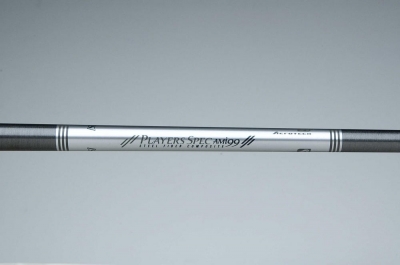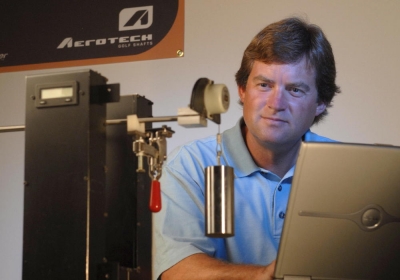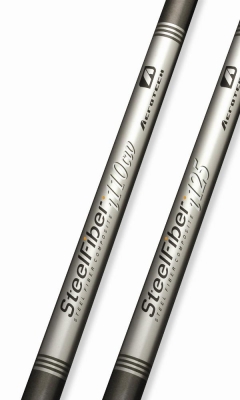By Jeffrey A. Rendall, Images Courtesy of Aerotech Golf
A couple years ago, we heard about a composite hockey stick manufacturer that was breaking into the golf shaft market, so we took a look at Aerotech Golf’s shafts in conjunction with a look at the Cleveland Launcher Comp driver. Very satisfied with the results, we surmised that it would be a good match to give Aerotech the nod to go with our new Miura Golf iron heads.
It was the perfect way to match the technology of the future with the ancient master craftsmanship of the past. Not surprisingly, it was a success.
Aerotech recommended that we try the new Players Spec irons shafts, a revolutionary new concept in iron shaft technology. Aerotech’s Vice President of Golf Operations, Chris Hilleary, explains the company’s thoughts behind the new shafts: “Our goal when designing this shaft was to create a golf shaft incorporating everything we’ve learned about composite iron shaft design into one model. The Players Spec shaft features our SteelFiber technology as well as a very unique weighting sequence making it one of the most playable high performance iron shafts ever produced.”
Weight sequence? That sounds intriguing. Golf manufacturers are always working with the weighting of golf club heads to achieve different effects, but does that go for golf shafts too? Apparently, yes.
“When we were in the testing stages of our various iron shaft designs we noticed that stronger players would have a tendency to pull their short irons in the lighter weight shaft designs, yet hit the long irons extremely well,” Hilleary lectured. “When we compared these test results with the new MOI (moment-of-inertia) matching research that has revealed that the shorter irons in a swing-weight matched set actually take less effort to swing than the longer irons, it fit perfectly with what we were seeing in our player tests.”
 |
As a result, Aerotech created a shaft design which gets progressively heavier as it gets shorter, allowing a player to continue benefiting from the easy-to-hit lighter weight long irons, yet maintain the control in the short irons that they have become accustomed to in their heavier steel shafts. The actual weight progression comes from a calculation of a MOI matched set of irons with standard seven-gram increment head weights.
This is where the ultimate in computer technology makes your golf game better, complete with blessings from the Golf Gods.
Aside from the new graduated weight of the shafts, I’ve never really understood the concept of different shafts and how they’ll actually improve your shot results. Golf club heads at least achieve some distinction with shapes and sizes… whereas all golf shafts look pretty much the same, except for paint patterns and steel versus graphite/composite.
Again, Hilleary sheds light where there was only confusion (or should we say, ignorance?) before: “Steel shafts are still being played by the majority of players at all levels – and this is because, up until now, a player always had to sacrifice some control and consistency when switching from steel to a composite in attempts to benefit from the lighter weights and vibration dampening of this material. Therefore, we set out eight years ago to design a composite iron shaft that maintained the control and consistency of a steel shaft.”
He continues, “It became apparent early on in the development stages that we could not accomplish this using carbon fiber alone. We needed to add a higher density material (steel fiber) to the matrix to achieve the performance benefits we were looking for. The SteelFiber design is actually the result of an evolution of designs over several years. Our unique way of combining steel and graphite has allowed us to create a shaft that has the benefits of both materials.”
Despite the fact that this type of iron shaft technology is constantly moving things forward, nearly all of the players you see on TV still use steel iron shafts. Hilleary says that’s because it’s very difficult to replicate the benefits of steel, but you’ll also start seeing more composite iron shafts as the years go on and the modern materials, innovative engineering and improved manufacturing processes start correcting the steel ‘prejudices’ of professional players.
 |
| Chris Hilleary |
Along those lines, Hilleary says they’re putting their time and resources into developing their products rather than push them hard at the top levels. “Through our extensive network of high-end custom fitters, we do know that there’s a lot of our product being played at the highest levels each and every week.”
Sounds kind of like the story at Miura Golf – the ‘big’ guys use it, they just don’t wear the company logos on their hats.
But you also can’t help but notice that nearly everyone uses composite/graphite shafts in their drivers and fairway woods. What makes the ‘long’ clubs different than irons?
“The biggest difference between iron and wood shafts is that generally with the driver, the ultimate goal is to hit the ball as far as you can with relatively good accuracy,” Hilleary explained. “The primary goal of an iron shaft is to consistently control distance and to have an appropriate distance progression between each club in a set. Most everyone understands that lighter weight shafts allow for longer club lengths and higher club head speed – which increases distance.”
It’s pretty simple to see why graphite dominates the driver shaft category. For irons, distance control is more important. In addition, iron heads are heavier by proportion, and are swung with a descending blow, and played from a variety of lies. This means that iron shafts have to cope with a large variety of impact conditions, making the torsional stiffness and tip stability of the shaft very critical.
All of these things you’ve probably never thought of – I just wondered why you get all these fashionable shaft designs with the big sticks and the irons are just shiny looking.
 |
Finally, we get to the bottom line. Are the more expensive golf shafts going to deliver for your dollar?
Hilleary has the final word. “The cost of manufacturing a golf shaft comes from cost of materials, level of complexity and consistency in manufacturing and intricacy of the graphics. You can be guaranteed that if the shaft is cheaper, then it was most likely produced with inexpensive materials and will not offer consistent performance for moderate to strong players.”
“On the other hand, I would caution you to be wary of the companies that are attempting to add perceived performance to their products by charging exorbitant prices,” Hilleary added.
Ah, the old notion of Caveat Emptor. Of course you should be careful in selecting iron shafts, as you would for any major golf purchase. Some of those names you certainly hear a lot from simply because of the advertising dollars involved – and others because someone might recommend them.
Only a knowledgeable club-fitter would know.
In addition to the Players Spec shafts, Aerotech has introduced some other models recently, all designed to maximize your particular performance. The SteelFiber i125 model fits nicely for players who have either been playing a graphite shaft in their wedges that’s too light, or for those who’ve always had steel shafts in their wedges – but now have graphite shafts in the rest of their irons.
 |
There’s also the SteelFiber i110, which will appeal to a stronger player who’s been using steel-shafted irons but wants to gain some of the benefits of a composite shaft. Finally, Aerotech introduced the new ALT470 shaft, which is designed for players with slower swings. This shaft features a super-soft flex profile, enabling players with slower swings to load the shaft properly. The shaft’s soft design incorporates a very active yet stable tip section that promotes a higher launch angle resulting in dramatic increases in carry distance.
I would certainly recommend that you consider Aerotech when you’re buying a set of clubs. I’ve had very good results with the Aerotech shafts fixed to Miura iron heads. I don’t have the experience level to tell you for certain that Aerotech has improved my golf game, though I’ve hit about as well as I’ve ever played with these irons.
If anything, the consistency makes the game more enjoyable – and if that’s all you’re asking for, then you’ve found a winner right from the start.
Details:
For further information on Aerotech, we suggest their website:
Aerotech Sports: http://www.aerotechsports.com
We’d also admonish you not to buy anything – balls, clubs or shafts – without consulting your local professional for some serious advice. Otherwise, you could be buying something that won’t give you your money’s worth.
| Related Links | Comments on this article? | |
|
Maryland National Golf Club Hollow Creek Golf Club Rocky Gap Resort PB Dye Golf Club in Ijamsville Whiskey Creek Golf Club |
E-mail Jeff Rendall, Editor: jrendall@golftheunitedstates.com |












